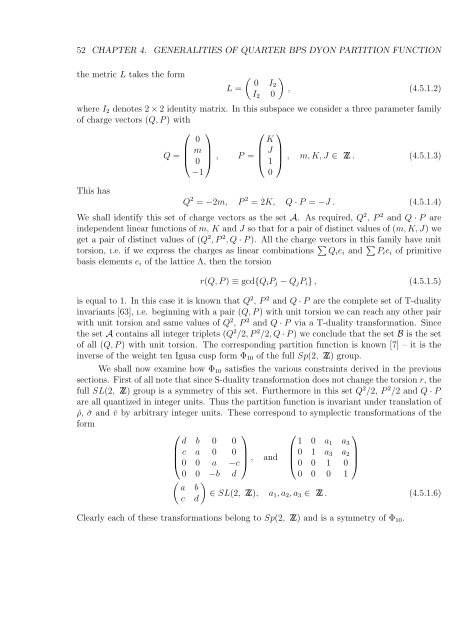PHYS08200604018 Shamik Banerjee - Homi Bhabha National ...
PHYS08200604018 Shamik Banerjee - Homi Bhabha National ...
PHYS08200604018 Shamik Banerjee - Homi Bhabha National ...
You also want an ePaper? Increase the reach of your titles
YUMPU automatically turns print PDFs into web optimized ePapers that Google loves.
52 CHAPTER 4. GENERALITIES OF QUARTER BPS DYON PARTITION FUNCTION<br />
the metric L takes the form<br />
L =<br />
( )<br />
0 I2<br />
, (4.5.1.2)<br />
I 2 0<br />
where I 2 denotes 2 × 2 identity matrix. In this subspace we consider a three parameter family<br />
of charge vectors (Q, P ) with<br />
⎛ ⎞ ⎛ ⎞<br />
0<br />
K<br />
Q = ⎜ m<br />
⎟<br />
⎝ 0 ⎠ , P = ⎜ J<br />
⎟<br />
⎝ 1 ⎠ , m, K, J ∈ Z . (4.5.1.3)<br />
−1<br />
0<br />
This has<br />
Q 2 = −2m, P 2 = 2K, Q · P = −J . (4.5.1.4)<br />
We shall identify this set of charge vectors as the set A. As required, Q 2 , P 2 and Q · P are<br />
independent linear functions of m, K and J so that for a pair of distinct values of (m, K, J) we<br />
get a pair of distinct values of (Q 2 , P 2 , Q · P ). All the charge vectors in this family have unit<br />
torsion, ı.e. if we express the charges as linear combinations ∑ Q i e i and ∑ P i e i of primitive<br />
basis elements e i of the lattice Λ, then the torsion<br />
r(Q, P ) ≡ gcd{Q i P j − Q j P i } , (4.5.1.5)<br />
is equal to 1. In this case it is known that Q 2 , P 2 and Q · P are the complete set of T-duality<br />
invariants [63], ı.e. beginning with a pair (Q, P ) with unit torsion we can reach any other pair<br />
with unit torsion and same values of Q 2 , P 2 and Q · P via a T-duality transformation. Since<br />
the set A contains all integer triplets (Q 2 /2, P 2 /2, Q · P ) we conclude that the set B is the set<br />
of all (Q, P ) with unit torsion. The corresponding partition function is known [7] – it is the<br />
inverse of the weight ten Igusa cusp form Φ 10 of the full Sp(2, Z) group.<br />
We shall now examine how Φ 10 satisfies the various constraints derived in the previous<br />
sections. First of all note that since S-duality transformation does not change the torsion r, the<br />
full SL(2, Z) group is a symmetry of this set. Furthermore in this set Q 2 /2, P 2 /2 and Q · P<br />
are all quantized in integer units. Thus the partition function is invariant under translation of<br />
ˇρ, ˇσ and ˇv by arbitrary integer units. These correspond to symplectic transformations of the<br />
form<br />
⎛<br />
⎞ ⎛<br />
⎞<br />
d b 0 0<br />
1 0 a 1 a 3<br />
⎜ c a 0 0<br />
⎟<br />
⎝ 0 0 a −c ⎠ , and ⎜ 0 1 a 3 a 2<br />
⎟<br />
⎝ 0 0 1 0 ⎠<br />
0 0 −b d<br />
0 0 0 1<br />
( )<br />
a b<br />
∈ SL(2, Z), a<br />
c d<br />
1 , a 2 , a 3 ∈ Z . (4.5.1.6)<br />
Clearly each of these transformations belong to Sp(2, Z) and is a symmetry of Φ 10 .

















